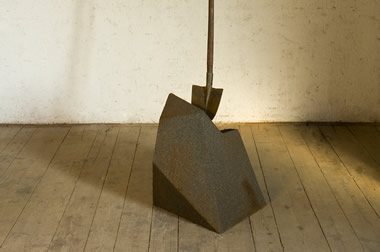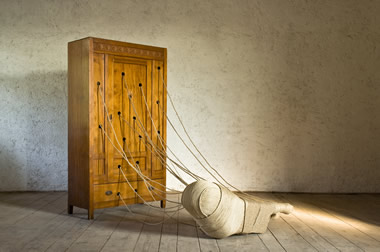


Carlo Vidoni (1968)
Al di là dell’evidente richiamo all’arte concettuale e poverista, a Vidoni preme sviluppare dei temi del surrealismo che gli sono cari, come l’inconscio: per lui, infatti, la forma di un’opera d’arte non viene da un atto razionale. Dall’Armadio (2009), ad esempio, preso da un rigattiere, poi forato, fuoriescono delle corde che da un interno inconoscibile (e per questo inquietante) si raggomitolano in una scultura dalle fattezze organiche, in un oggetto informe che però possiede degli abbozzi di articolazioni e di capo.
Le corde per Vidoni simbolizzano, in quest’opera, un legame con un inconscio rinchiuso nel vano di un armadio e che si esplicita in una presenza non formata. Il ricorso all’archetipo, come quello uomo-natura, è per l’artista fondamentale: per lui l’arte è una necessità primaria ed egli definisce gli archetipi proprio come necessità primarie che giungono all’artista e che poi l’artista rilascia alla collettività con le sue opere.
Besides a connection to conceptual art and arte povera, Vidoni is concerned about Surrealism’s unconsciousness and in fact he believes that the shape of an artwork is not produced by a rational gesture. The Armadio is an old wardrobe found in a second-hand shop that has been pierced by Vidoni. Out of these holes and from an unknown and disquieting interior comes ropes that huddle up to form a shape slightly resembling a head and arms.
These ropes symbolize a link with the unconscious contained by the wardrobe, that reaches an unfinished form. Vidoni considers it essential to work on an archetype as that of man and nature. He thinks that art is for him a primary necessity as with archetypes that come to the artist and subsequently are given back to people through his artworks.
Artisti
Castello e Palazzo Altan
- Nika Autor
- Ksenija Čerče
- Alessandra Ghiraldelli
- Polona Maher
- Lorena Matic
- Lorenzo Oggiano
- Michele Spanghero
- Carlo Vidoni








